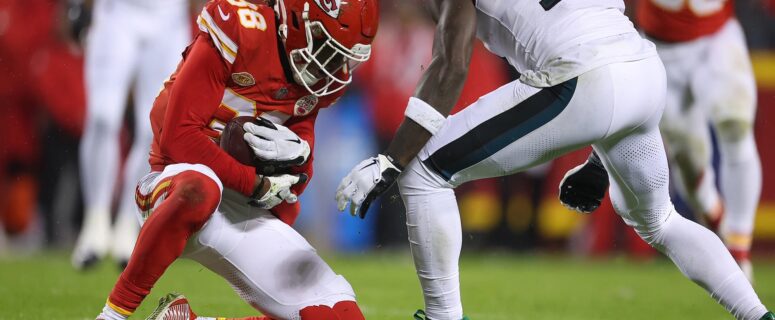KANSAS CITY, Mo. — Despite a 17-7 lead at halftime and another stifling defensive performance, the Chiefs picked up their second loss in three games as the Philadelphia Eagles claimed a 21-17 victory in a rematch of last season’s Super Bowl opponents.
Monday night’s loss echoed recurring themes from the first half of the season as the Chiefs committed seven penalties for 55 yards, turned the ball over twice, converted only two of four red-zone opportunities, and suffered another series of dropped passes that stalled drives for head coach Andy Reid’s offense.
“We’re kind of shooting ourselves in the foot,” Reid said. “I’ve got to do a better job helping out with that and then my guys have got to do the same thing. So, we’ve all got to pick it up a notch there in the second half. (We’re) just not as sharp there. We’ll work on that.”
The Chiefs seemed to have their offense moving in the right direction in the first half, staking a 10-point lead behind 190 yards of total offense that included 121 yards on the ground. Kansas City averaged 6.1 yards per carry in the first half, despite Patrick Mahomes throwing for just 78 yards. But the offense couldn’t sustain that momentum in the second half, mustering only 146 yards. A red-zone fumble by Travis Kelce ended the team’s best drive of the second half.
“I’ve got to be better,” Kelce said. “I’m just not playing up to the level I have in the past. I’ve got to be better.”
Mahomes said he doesn’t have any concerns that the offense will eventually find its footing.
“I know how hard the guys work at the end of the day,” Mahomes said. “I can see it – I mean, the first half you can see the guys moving down the field, you can see we’ve had spurts where we’ve played good football offensively. All you can do is go to work and try to get better and better.”
Sneed, McDuffie Shine
The Eagles netted just 124 yards passing Monday night largely due to the standout performance of the cornerback duo L’Jarius Sneed and Trent McDuffie. Sneed trailed Eagles receiver AJ Brown during the game, holding him to just one catch for 8 yards while also intercepting a pass. Brown entered the evening averaging 7.4 catches and 111.7 yards per game.
According to NFL Next Gen Stats, Sneed was targeted seven times yielding three catches for 22 yards. The Eagles targeted McDuffie just twice with a single reception for 5 yards. McDuffie also picked up two sacks. While Brown’s running mate DeVonta Smith hauled in six catches for 99 yards, none of those receptions came with Sneed or McDuffie in coverage.
“I thought they did a heck of a job,” Reid said. “Those are two of the best receivers around, so I thought they did a heck of a job.”
McDuffie credited Sneed for taking on the assignment of traveling with Brown in helping out the rest of the secondary.
“He followed (Brown) the whole game,” McDuffie said. “When you have a DB like that, who can just go out and cover their best receivers, it makes it easier for the rest of us.”
The Quarterback Draw
For the Chiefs defense, the decisive play of the second half wasn’t the 41-yard bomb from Jalen Hurts to Smith that set up a quarterback sneak for the go-ahead score in the fourth quarter. Instead, it was Philadelphia’s third-quarter touchdown when Hurts ran a quarterback draw for 10 yards virtually untouched.
The play came on a third-and-5. The difference between holding the Eagles to a field goal there instead of a touchdown there proved to be the final margin of the game.
Worst of all, the Chiefs knew it was coming, said defensive lineman Chris Jones.
“Look at the red zone, the defense, we talked about it all week,” Jones explained. “Eagle formation, empty, we knew it was the quarterback draw, we got up-field and gave up the touchdown.”
If the Chiefs defense has a flaw, it might be found in the run game. The Eagles rushed for 114 yards Monday night, the eighth time in 10 games the Chiefs have surrendered 100 yards or more on the ground.
“If you put us in passing situations, I think we excel in that,” Jones said. “I think more stopping the run. I think they had 120 (rushing yards) on us today, so that’s a point of emphasis this week. As much as we excel in pass rushing, we have to stop the run.”
When asked what was the difference between the first half and the second half for the Kansas City defense, Jones had a short answer.
“Quarterback draw,” he said.
Sack Party
The Chiefs hoped to put pressure on Hurts in the pocket, and theydid just that in the first half with five quarterback sacks. The defense also had 15 quarterback pressures, with Jones picking up two sacks and four pressures in his 42 snaps.
“I think overall, we’ve been really good as a pass rush as a unit,” Jones said. “I think we have a lot of good guys who can rush the passer. We have George Karlaftis, Mike Danna – they both have, what, 6.5 sacks? Look at the overall group and the success we’ve had rushing the passer, I don’t think that’s what we look forward to when we’re looking ahead.”
Indeed, when Jones has a big game, the Kansas City pass defense normally thrives, as it did against the Eagles.
“Chris Jones is one of those guys that can make a difference each and every down,” McDuffie said. “He controlled the inside, which is great against the run. Somebody like that, I feel like offenses have to game plan against that, offensive lines have to see where 95 is. He opens up a lot of lanes for our linebackers and definitely makes it a lot easier for the DBs to go out there and cover.”
Toney Jumpstart
After averaging fewer than 11 snaps in the last three games, Kadarius Toney played a combined 28 snaps against the Eagles. That’s the second-highest workload of the season for Toney behind the 30 snaps he played against Denver in Week 6, and his usage paid dividends for the Chiefs all night long.
On the team’s first-quarter touchdown drive, Toney took a handoff out of the backfield for 14 yards. The play was remiscient to how the Chiefs occassionally used Tyreek Hill as a running back during his rookie season in 2016. Toney also caught a pass for 7 yards on the drive.
Then a thumb injury forced Mecole Hardman out of the game for a period of time, Toney stepped into the punt return role and immediately provided a spark. Toney returned six punts for 58 yards, averaging 9.7 yards per return. The Chiefs as a team entered Monday night averaging 7.0 yards on 21 returns through the first nine games of the season.
Toney missed training camp following knee surgery and has battle toe and ankle injuries during the season. That has limited what the Chiefs have been able to do with him thus far, Reid said.
“It’s mainly the health part,” Reid explained. “He had a great week of practice. I’ve been cautious with him with his knee. We upped his load this week and he handled it. Did a good job.”
What is a False Start?
Think you know the textbook definition of a false start by an offensive lineman? Monday night’s game introduced a curious interpretation of the rule that puzzled both the Chiefs and viewers.
The play occurred with 5:46 remaining in the game. The Eagles took a 21-17 lead on the previous possession, and the Chiefs offense was hoping to respond. The team faced a third-and-7 when Eagles defense end Brandon Graham appeared to jump offsides.
After huddling for a consultation, referee Shawn Smith called Chiefs center Creed Humphrey for a false start. Smith explained in a pool report after the game why his crew called the penalty on Humphrey.
“What we had in that situation was movement by the defense, but we had the center abruptly dropping his behind which caused a reaction by the defense,” Smith said. “So, his abrupt movement, the defense reacts to that, so we put that on the offense in that situation.”
While Humphrey’s motion appeared consistent with his normal setup as well as comparable to that of other centers, Smith deemed the “abruptness” of Humphrey’s dropping into a squatting position provoked the defender.
“What we deemed in that situation was when you have an abrupt movement by the offense and the defense reacts to that by jumping into the neutral zone, then the abrupt movement by the offense causes the defense to react,” Smith explained.
Reid said he didn’t receive a satisfactory explanation for the call from the officiating crew.
“No, I didn’t,” Reid said. “They said he dipped his rear end. He does that a lot, it’s not the first time. Centers do that. I’ll look at. I got that and a different answer from someone else.”


